The Geochronology and Geochemistry of Zircon as Evidence for the Reconcentration of REE in the Triassic Period in the Chungju Area, South Korea
Abstract
1. Introduction
2. Geological Setting
3. Methods
3.1. EPMA
3.2. LA-ICP-MS
3.3. Laser Ablation Multi-Collector (LA-MC)-ICP-MS
4. Results
4.1. Quartz–Allanite Vein and Zircon Occurrence in the Gyemyeongsan Formation
4.2. Geochronology
4.3. Zircon Composition
5. Discussion and Conclusions
Author Contributions
Funding
Conflicts of Interest
References
- Oh, M.S. Allanite mineralization in the Mt. Eorae area. Econ. Environ. Geol. 1989, 22, 151–166. (In Korean) [Google Scholar]
- Park, M.E.; Kim, G.S. Genesis of the REE ore deposits, Chungju District, Korea: Occurrence features and geochemical characteristics. Econ. Environ. Geol. 1995, 28, 599–612. (In Korean) [Google Scholar]
- Park, M.E.; Kim, G.S. Zircon deposit and rare earth element enriched metasomatic alkaline rocks at Kyemyeongsan Formation, Chungju, Korea: Paleozoic magmatism and Zr–REE–Nb mineralization. Geosci. Res. NE Asia 1999, 2, 61–73. [Google Scholar]
- Kim, J.S.; Park, M.E.; Kim, G.S. A geochemical study of the alkali granite in the Kyeomyeongsan Formation. Econ. Environ. Geol. 1998, 31, 349–360. (In Korean) [Google Scholar]
- Park, M.E.; Kim, G.S.; Choi, I.S. Geochemical characteristics of allanite from rare metal deposits in the Chungju area, Chungcheongbuk-Do (Province), Korea. Econ. Environ. Geol. 1996, 29, 544–559. (In Korean) [Google Scholar]
- Park, M.E.; Kim, G.S.; Choi, I.S. Geochemical and petrographical studies on the fergusonite associated with the Nb–Y mineralization related to the alkaline granite, Kyemyeongsan Formation, Korea. Econ. Environ. Geol. 1997, 30, 395–406. (In Korean) [Google Scholar]
- Park, M.E.; Kim, G.S. Geochemistry of uranium and thorium deposits from the Kyemyeongsan pegmatite. Econ. Environ. Geol. 1998, 31, 365–374. (In Korean) [Google Scholar]
- You, B.W.; Lee, G.J.; Koh, S.M. Mineralogy and Mineral-chemistry of REE minerals Occurring at Mountain Eorae, Chungju. Econ. Environ. Geol. 2012, 45, 643–659. (In Korean) [Google Scholar] [CrossRef]
- Cheong, C.S.; Kim, N.; Yi, K.; Jo, H.J.; Jeong, Y.J.; Kim, Y.; Koh, S.M.; Iizuka, T. Recurrent rare earth element mineralization in the northwestern Okcheon Metamorphic Belt, Korea: SHRIMP U–Th–Pb geochronology, Nd isotope geochemistry, and tectonic implications. Ore Geol. Rev. 2015, 71, 99–115. [Google Scholar] [CrossRef]
- No, S.G.; Park, M.E. Bands of zircon, allanite and magnetite in Paleozoic alkali granite in the Chungju Unit, South Korea, and origin of REE mineralizations. Minerals 2019, 9, 566. [Google Scholar] [CrossRef]
- Cho, M.; Kim, H. Metamorphic evolution of the Ogcheon metamorphic belt: Review and new age constraints. Int. Geol. Rev. 2005, 37, 41–57. [Google Scholar] [CrossRef]
- Oh, C.W. A new concept on tectonic correlation between Korea, China and Japan: Histories from the late Proterozoic to Cretaceous. Gondwana Res. 2006, 9, 47–61. [Google Scholar] [CrossRef]
- Lee, S.R.; Cho, M.; Cheong, C.-S.; Kim, H.; Wingate MT, D. Age, geochemistry, and tectonic significance of Neoproterozoic alkaline granitoids in the northwestern margin of the Gyeonggi massif, South Korea. Precambrian Res. 2003, 122, 297–310. [Google Scholar] [CrossRef]
- Lee, K.S.; Chang, H.W.; Park, K.H. Neoproterozoic bimodal volcanism in the central Ogcheon belt, Korea: Age and tectonic implication. Precambrian Res. 1998, 89, 47–57. [Google Scholar] [CrossRef]
- Cluzel, D.; Cadet, J.P.; Lapierre, H. Geodynamics of the Ogcheon belt (South Korea). Tectonophysics 1990, 183, 41–56. [Google Scholar] [CrossRef]
- Cluzel, D.; Jolivet, L.; Cadet, J. Early Middle Paleozoic intraplate orogeny in the Ogcheon Belt (South Korea): A new insight on the Paleozoic buildup of East Asia. Tectonics 1991, 10, 1130–1151. [Google Scholar] [CrossRef]
- Cluzel, D. Ordovician bimodial magmatism in the Okcheon belt (South Korea): An intracontinental rift-related volcanic activity. J. Southeast Asian Earth Sci. 1992, 7, 195–209. [Google Scholar] [CrossRef]
- Glitter, T.M. Data Reduction Software (Macquarie Univ.)—GEMOC. Available online: http://www.glitter-gemoc.com (accessed on 5 January 2020).
- Paton, C.; Woodhead, J.D.; Hellstrom, J.C.; Hergt, J.M.; Greig, A.; Maas, R. Improved laser ablation U–Pb zircon geochronology through robust downhole fractionation correction. Geochem. Geophys. Geosyst. 2010, 11. [Google Scholar] [CrossRef]
- Stacey, J.S.; Kramers, J.D. Approximation of terrestrial lead isotope evolution by a 2-stage model. Earth Planet. Sci. Lett. 1975, 26, 207–221. [Google Scholar] [CrossRef]
- Andersen, T.; Griffin, W.L.; Jackson, S.E.; Knudsen, T.-L.; Pearson, N.J. Mid-Proterozoic magmatic arc evolution at the southwest margin of the Baltic Shield. Lithos 2004, 73, 289–318. [Google Scholar] [CrossRef]
- Wiedenbeck, M.A.P.C.; Alle, P.; Corfu, F.; Griffin, W.L.; Meier, M.; Oberli, F.V.; Quadt, A.V.; Roddick, J.C.; Spiegel, W. Three natural zircon standards for U–Th–Pb, Lu–Hf, trace element and REE analyses. Geostand. Newsl. 1995, 19, 1–23. [Google Scholar] [CrossRef]
- Sláma, J.; Košler, J.; Condon, D.J.; Crowley, J.L.; Gerdes, A.; Hanchar, J.M.; Horstwood, M.S.; Morris, G.A.; Nasdala, L.; Norberg, N.; et al. Plešovice zircon—A new natural reference material for U–Pb and Hf isotopic microanalysis. Chem. Geol. 2008, 249, 1–35. [Google Scholar] [CrossRef]
- Ludwig, K.R. Manual for Isoplot 3.7; Special Publication No. 4; Berkeley Geochronology Center: Berkeley, CA, USA, 2008; p. 77. [Google Scholar]
- Andersen, T. Correction of common lead in U–Pb analyses that to not report 204Pb. Chem. Geol. 2002, 192, 59–79. [Google Scholar] [CrossRef]
- Hoskin, P.W.O.; Black, L.P. Metamorphic zircon formation by solid-state recrystallization of protolith igneous zircon. J. Metamorph. Geol. 2000, 18, 423–439. [Google Scholar] [CrossRef]
- Kim, M.-J.; Park, K.-H.; Yi, K.; Koh, S.M. Timing of metamorphism of the metavoclanics within the Gyemyeongsan Formation. J. Petrol. Soc. Korea 2013, 22, 291–298. (In Korean) [Google Scholar] [CrossRef]
- Liati, A.; Gebauer, D. Constraining the prograde and retrograde P–T path of Eocene HP rocks by SHRIMP dating of different zircon domains: Inferred rates of heating, burial, cooling and exhumation for central Rhodope, northern Greece. Contrib. Mineral. Petrol. 1999, 135, 340–354. [Google Scholar] [CrossRef]
- Bingen, B.; Austrheim, H.; Whitehouse, M. Ilmenite as a source for zirconium during high-grade metamorphism? Textural evidence from the Caledonides of W. Norway and implications for zircon geochronology. J. Petrol. 2001, 42, 355–375. [Google Scholar] [CrossRef]
- Pan, Y. Zircon- and monazite-forming metamorphic reactions at Manitouwadge, Ontario. Can. Mineral. 1997, 35, 105–118. [Google Scholar]
- Roberts, M.P.; Finger, F. Do U–Pb zircon ages from granulites reflect peak metamorphic conditions? Geology 1997, 25, 319–322. [Google Scholar] [CrossRef]
- Degeling, H.; Eggins, S.; Ellis, D.J. Zr budgets for metamorphic reactions, and the formation of zircon from garnet breakdown. Mineral. Mag. 2001, 65, 749–758. [Google Scholar] [CrossRef]
- Whitehouse, M.J.; Platt, J.P. Dating high-grade metamorphism—Constraints from rare-earth elements in zircon and garnet. Contrib. Mineral. Petrol. 2003, 145, 61–74. [Google Scholar] [CrossRef]
- Bea, F.; Montero, P. Behaviour of accessory phases and redistribution of Zr, REE, Y, Th and U during metamorphism and partial melting of metapelites in the lower crust: An example from the Kinzigite Formation of Ivrea-Verbano, NW Italy. Geochim. Cosmochim. Acta 1999, 63, 1133–1153. [Google Scholar] [CrossRef]
- Moller, A.; O’Brien, P.J.; Kennedy, A.; Kroner, A. Polyphase zircon in ultrahigh-temperature granulites (Rogaland, SW Norway): Constraints for Pb diffusion in zircon. J. Metamorph. Geol. 2002, 20, 727–740. [Google Scholar] [CrossRef]
- Rubbatto, D. Zircon: The metamorphic mineral. Rev. Mineral. Geochem. 2017, 83, 261–295. [Google Scholar] [CrossRef]
- Cho, M.; Cheong, W.; Ernst, W.G.; Yi, K.; Kim, J. SHRIMP U–Pb ages of detrital zircons in metasedimentary rocks of the central Ogcheon fold-thrust belt, Korea: Evidence for tectonic assembly of Paleozoic sedimentary protoliths. J. Asian Earth Sci. 2013, 63, 234–249. [Google Scholar] [CrossRef]
- Hoskin, P.W.O.; Schaltegger, U. The composition of zircon and igneous and metamorphic petrogenesis. Rev. Mineral. Geochem. 2003, 53, 27–62. [Google Scholar] [CrossRef]
- Chen, Z.Y.; Zhang, L.F.; Lu, Z.; Du, J.X. Episodic fluid action in Chinese southwestern Tianshan HP/UHP metamorphic belt: Evidence from U–Pb dating of zircon in vein and host eclogite. Minerals 2019, 9, 727. [Google Scholar] [CrossRef]
- Hoskin, P.W.O. Trace-element composition of hydrothermal zircon and the alteration of Hadean zircon from the Jack Hills, Australia. Geochim. Cosmochim. Acta 2005, 69, 637–648. [Google Scholar] [CrossRef]
- Yang, W.B.; Niu, H.C.; Shan, Q.; Sun, W.D.; Zhang, H.; Li, N.B.; Jiang, Y.H.; Yu, X.Y. Geochemistry of magmatic and hydrothermal zircon from the highly evolved Baerzhe alkaline granite: Implications for Zr–REE–Nb mineralization. Miner. Depos. 2014, 29, 451–470. [Google Scholar] [CrossRef]
- Cheong, C.-S.; Jeong, G.Y.; Kim, H.; Lee, S.-H.; Choi, M.S.; Cho, M. Early Permian peak metamorphism recorded in U–Pb system of black slates from the Ogcheon metamorphic belt, South Korea, and its tectonic implication. Chem. Geol. 2003, 193, 81–92. [Google Scholar] [CrossRef]
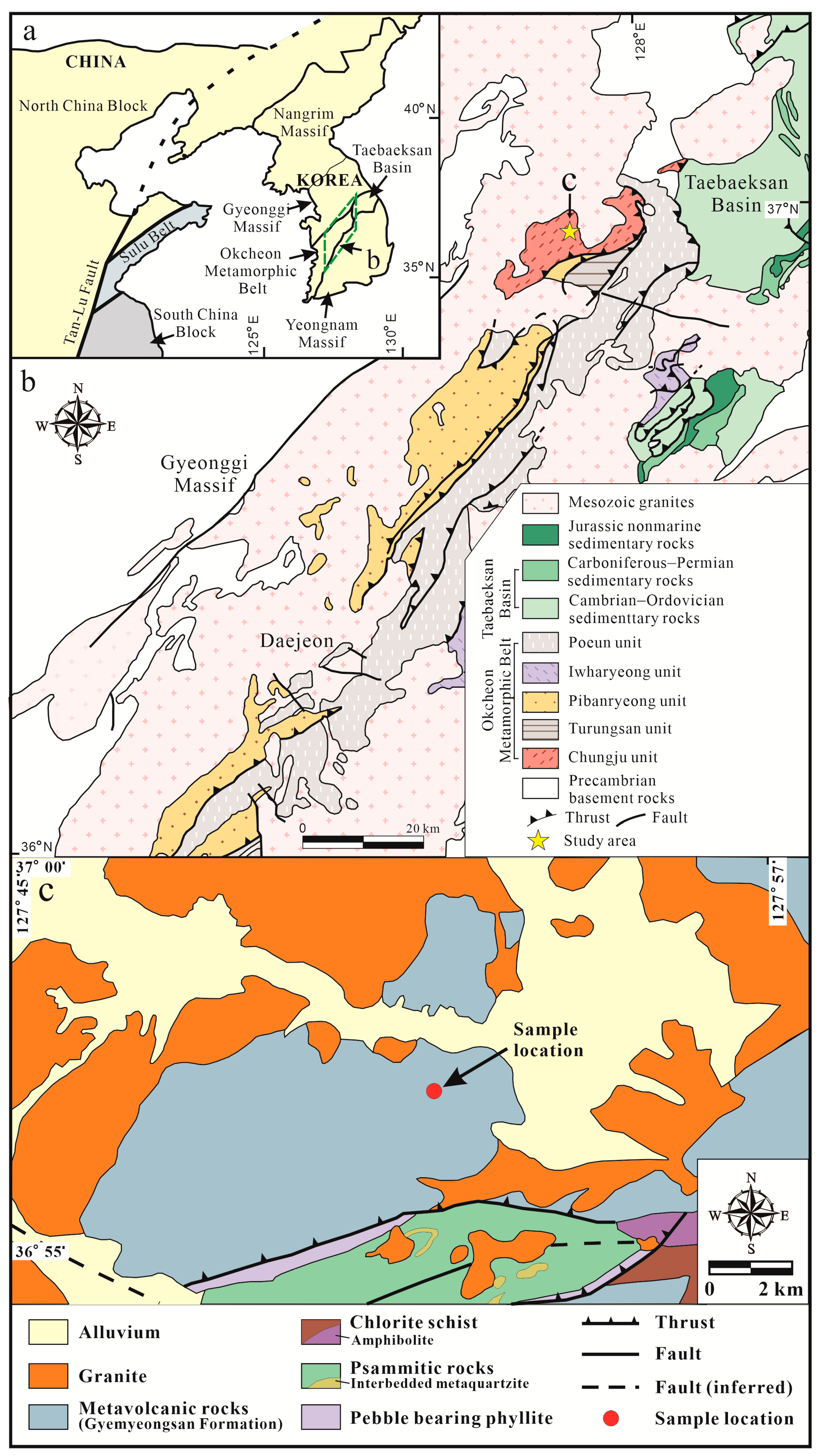
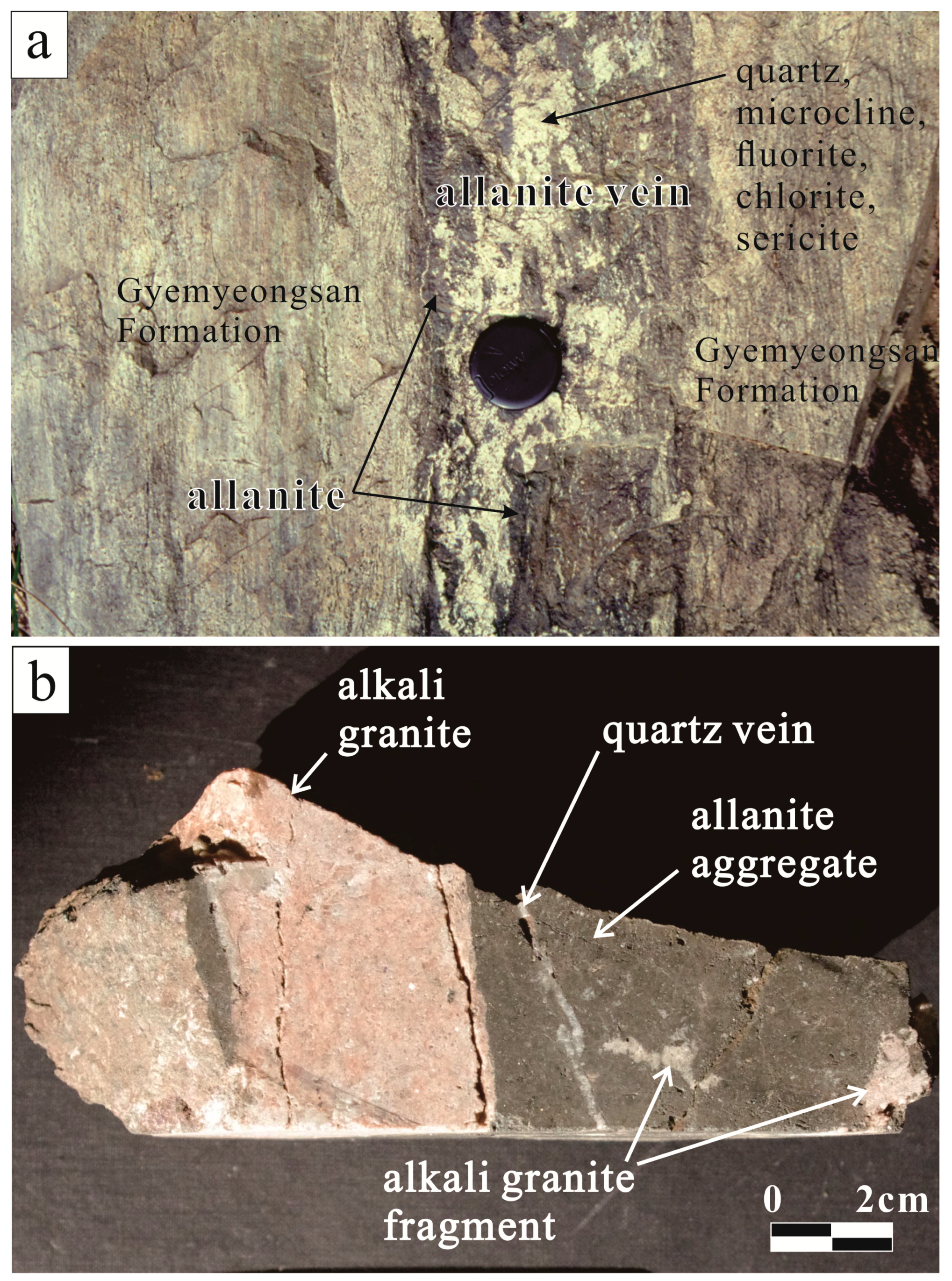
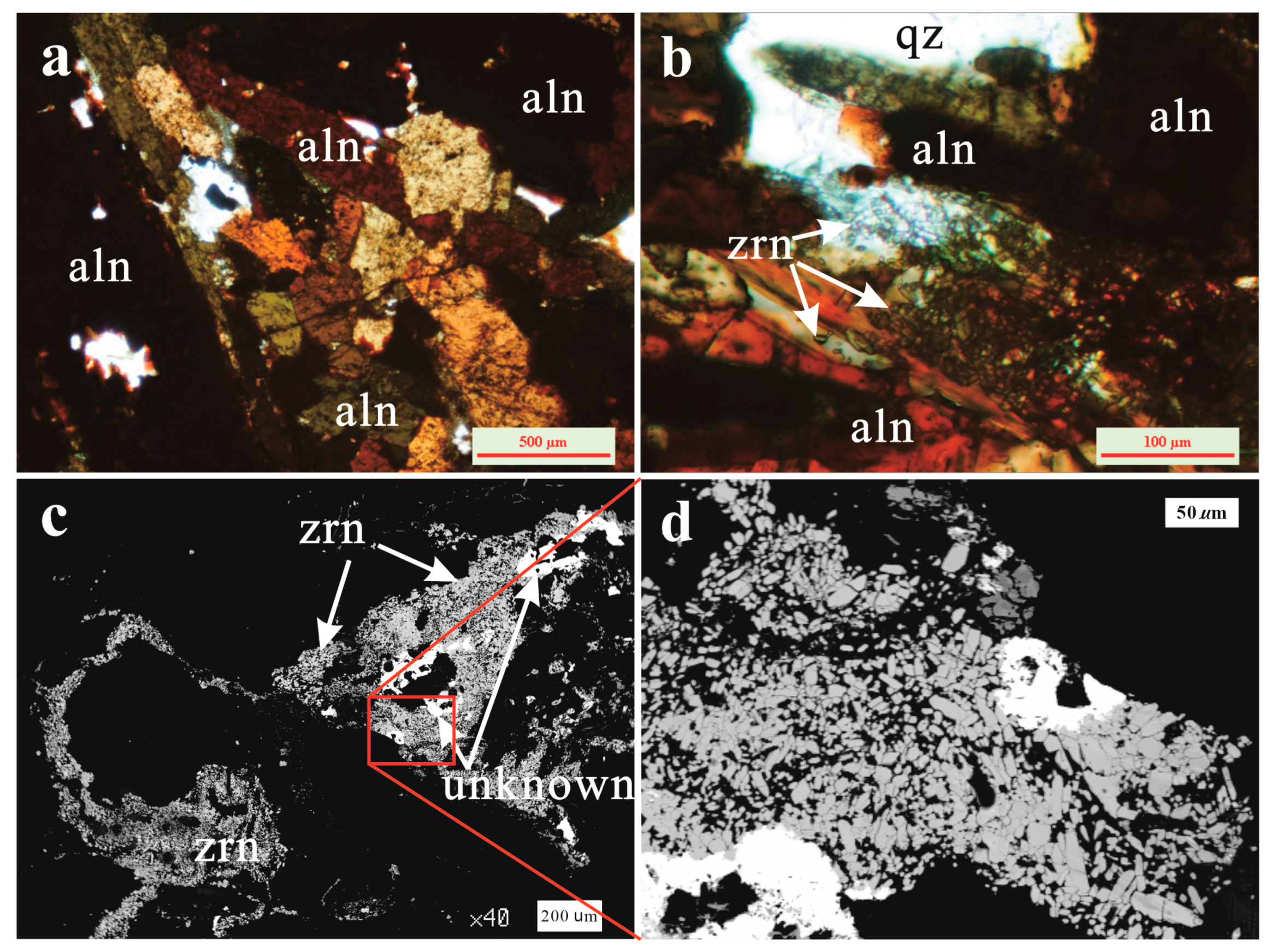
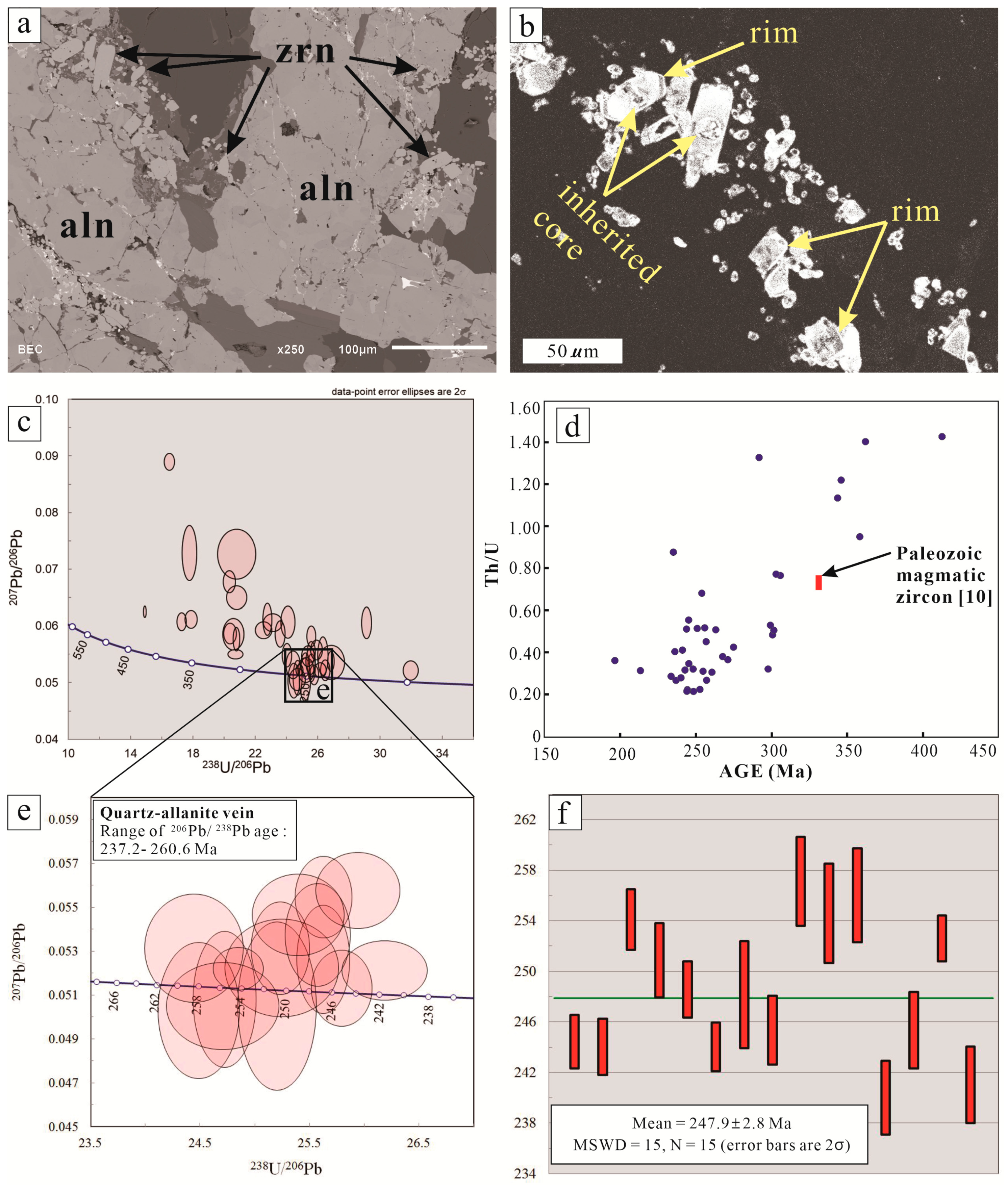
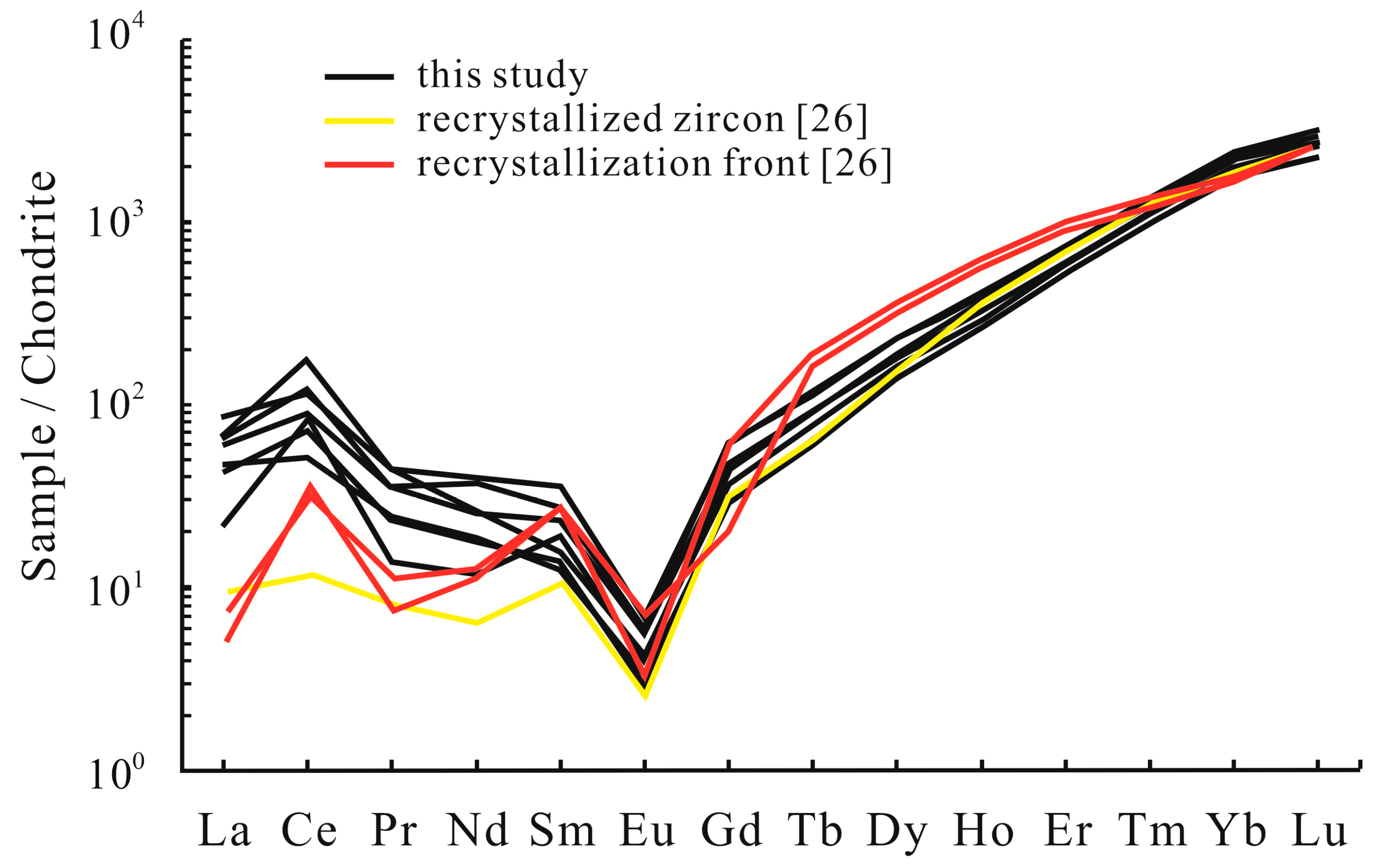
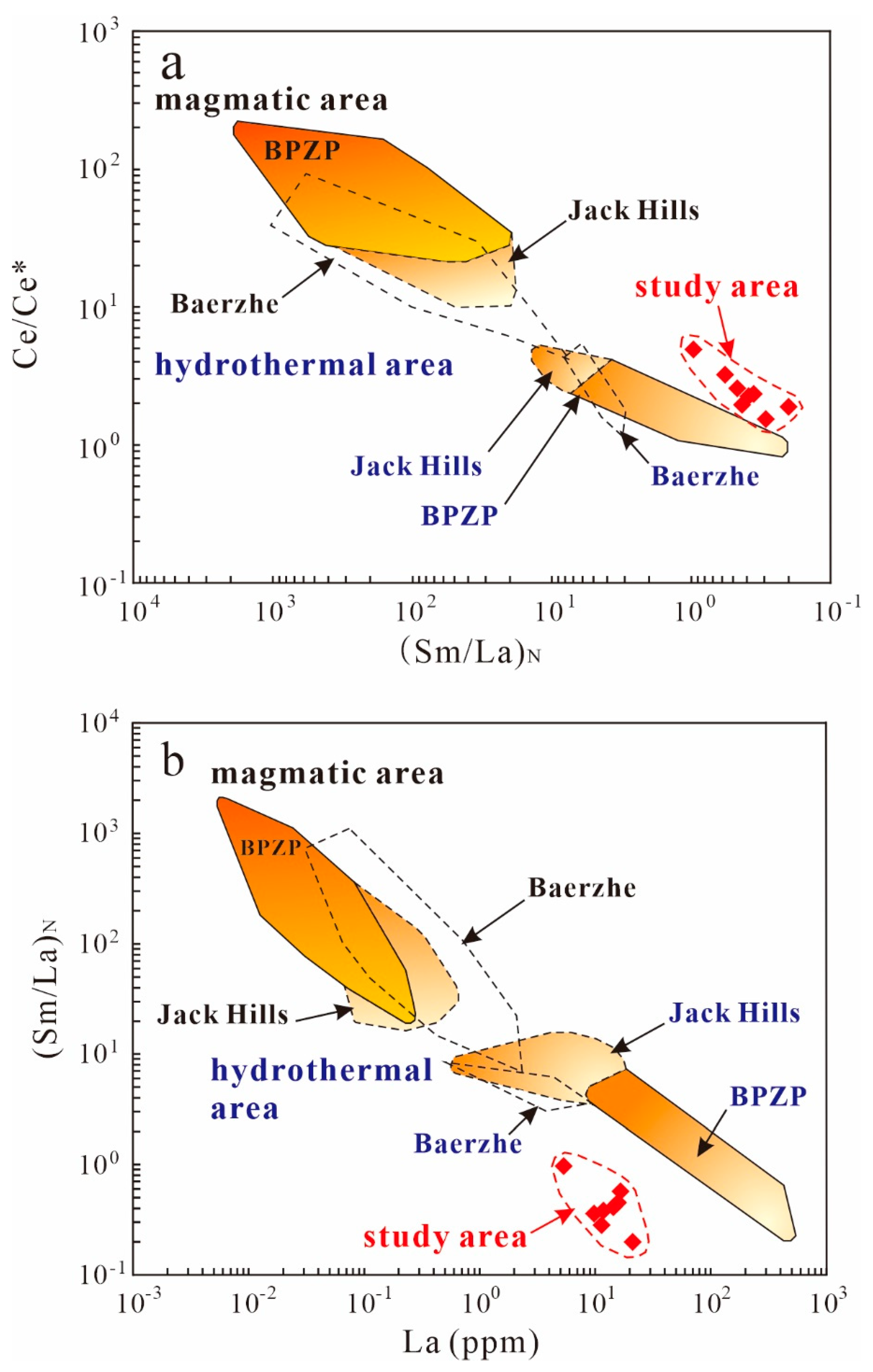
| Non Correction Ratio | Anderson Correction Age [25] | |||||||||
|---|---|---|---|---|---|---|---|---|---|---|
| No. | U (ppm) | Th (ppm) | Pb (ppm) | Th/U | 238Pb/206U | 2σ | 207Pb/206Pb | 2σ | 206Pb/238U | 2σ |
| 1 | 462 | 715 | 232 | 1.43 | 14.938750 | 0.071413 | 0.062570 | 0.000810 | 412.6 | 2.3 |
| 2 | 407 | 145 | 14 | 0.36 | 32.000000 | 0.399360 | 0.052200 | 0.001400 | 196.4 | 2.7 |
| 3 | 434 | 238 | 66 | 0.53 | 20.833330 | 0.520833 | 0.065000 | 0.001700 | 299.2 | 8.0 |
| 4 | 116 | 80 | 9 | 0.68 | 24.740230 | 0.232590 | 0.050900 | 0.002500 | 254.1 | 2.4 |
| 5 | 113 | 57 | 6 | 0.51 | 25.214320 | 0.292451 | 0.050600 | 0.003100 | 250.9 | 2.9 |
| 6 | 286 | 126 | 29 | 0.42 | 22.558090 | 0.432537 | 0.059300 | 0.001200 | 275.1 | 5.4 |
| 7 | 411 | 596 | 223 | 1.40 | 16.528930 | 0.273205 | 0.089000 | 0.001200 | 362.2 | 6.3 |
| 8 | 229 | 103 | 17 | 0.45 | 24.119630 | 0.378142 | 0.060700 | 0.002300 | 256.9 | 3.5 |
| 9 | 175 | 250 | 12 | 0.88 | 26.917900 | 0.688345 | 0.053600 | 0.002500 | 235.2 | 6.5 |
| 10 | 266 | 74 | 9 | 0.26 | 26.518160 | 0.246125 | 0.052200 | 0.001500 | 236.9 | 2.4 |
| 11 | 168 | 65 | 8 | 0.40 | 26.371310 | 0.271224 | 0.054700 | 0.002800 | 236.1 | 3.1 |
| 12 | 276 | 60 | 8 | 0.22 | 25.634450 | 0.197138 | 0.052700 | 0.002000 | 244.5 | 2.1 |
| 13 | 197 | 76 | 12 | 0.38 | 23.148150 | 0.492970 | 0.060600 | 0.001300 | 267.8 | 5.7 |
| 14 | 488 | 104 | 12 | 0.21 | 25.246150 | 0.216705 | 0.053200 | 0.001700 | 248.6 | 2.2 |
| 15 | 305 | 158 | 19 | 0.51 | 25.634450 | 0.210280 | 0.055500 | 0.001500 | 244.1 | 1.9 |
| 16 | 323 | 103 | 13 | 0.32 | 25.258900 | 0.421088 | 0.052300 | 0.001800 | 248.2 | 4.2 |
| 17 | 233 | 80 | 11 | 0.35 | 25.581990 | 0.242142 | 0.053800 | 0.001900 | 245.4 | 2.7 |
| 18 | 636 | 696 | 177 | 1.13 | 17.793590 | 0.379934 | 0.072900 | 0.004000 | 343.6 | 6.3 |
| 19 | 349 | 188 | 48 | 0.51 | 20.755500 | 0.392020 | 0.055060 | 0.000690 | 301.2 | 5.8 |
| 20 | 201 | 54 | 9 | 0.27 | 24.503800 | 0.300218 | 0.050400 | 0.002500 | 257.1 | 3.5 |
| 21 | 229 | 69 | 9 | 0.31 | 24.721880 | 0.415597 | 0.050600 | 0.001600 | 254.6 | 3.9 |
| 22 | 311 | 154 | 35 | 0.48 | 20.618560 | 0.552662 | 0.058600 | 0.002300 | 300.7 | 8.5 |
| 23 | 283 | 59 | 7 | 0.21 | 25.799790 | 0.226314 | 0.051400 | 0.001400 | 244.1 | 2.2 |
| 24 | 162 | 84 | 11 | 0.52 | 24.461840 | 0.365013 | 0.053200 | 0.002000 | 256.0 | 3.7 |
| 25 | 438 | 121 | 13 | 0.28 | 26.191720 | 0.315563 | 0.052200 | 0.001100 | 240.1 | 2.9 |
| 26 | 398 | 307 | 82 | 0.77 | 20.374900 | 0.319655 | 0.067800 | 0.001600 | 303.0 | 4.8 |
| 27 | 366 | 203 | 36 | 0.55 | 25.406500 | 0.342110 | 0.054700 | 0.001500 | 245.4 | 3.0 |
| 28 | 337 | 108 | 24 | 0.32 | 20.820320 | 0.177729 | 0.057700 | 0.001700 | 297.9 | 2.9 |
| 29 | 342 | 79 | 9 | 0.22 | 24.863250 | 0.185454 | 0.052270 | 0.000790 | 252.6 | 1.8 |
| 30 | 303 | 128 | 15 | 0.41 | 25.947070 | 0.309695 | 0.055800 | 0.001400 | 241.1 | 3.0 |
| 31 | 343 | 126 | 23 | 0.36 | 22.794620 | 0.233818 | 0.061200 | 0.002300 | 271.0 | 2.3 |
| 32 | 575 | 285 | 54 | 0.51 | 23.629490 | 0.256842 | 0.058600 | 0.001900 | 263.1 | 3.0 |
| 33 | 713 | 675 | 172 | 0.95 | 17.304030 | 0.254515 | 0.060800 | 0.001300 | 358.3 | 5.4 |
| 34 | 409 | 123 | 17 | 0.30 | 24.061600 | 0.237374 | 0.054900 | 0.001700 | 260.5 | 3.1 |
| 35 | 284 | 90 | 14 | 0.31 | 25.627880 | 0.229876 | 0.058200 | 0.001500 | 242.7 | 2.3 |
| 36 | 292 | 362 | 111 | 1.22 | 17.921150 | 0.321168 | 0.061200 | 0.001300 | 346.0 | 6.3 |
| 37 | 444 | 345 | 91 | 0.77 | 20.416500 | 0.337635 | 0.058700 | 0.001500 | 305.7 | 5.4 |
| 38 | 478 | 652 | 109 | 1.33 | 20.833330 | 0.998264 | 0.072700 | 0.003600 | 292.0 | 13.0 |
| 39 | 166 | 53 | 10 | 0.31 | 29.163020 | 0.263649 | 0.060600 | 0.002300 | 213.3 | 1.8 |
| 40 | 240 | 66 | 8 | 0.28 | 26.874500 | 0.180560 | 0.053800 | 0.001400 | 233.7 | 1.4 |
| Spots | SiO2 | HfO2 | UO2 | Al2O3 | Ce2O3 | ThO2 | La2O3 | PbO | TiO2 | ZrO2 | Y2O3 | Total |
|---|---|---|---|---|---|---|---|---|---|---|---|---|
| 1 | 32.5 | 1.8 | <0.1 | <0.1 | 0.3 | <0.1 | <0.1 | <0.1 | <0.1 | 63.7 | <0.1 | 98.6 |
| 2 | 32.6 | 1.7 | <0.1 | 0.2 | 0.2 | <0.1 | <0.1 | <0.1 | <0.1 | 64.4 | <0.1 | 99.3 |
| 3 | 33.1 | 1.8 | <0.1 | <0.1 | <0.1 | <0.1 | <0.1 | <0.1 | <0.1 | 65.0 | <0.1 | 100.1 |
| 4 | 32.6 | 1.7 | <0.1 | <0.1 | <0.1 | <0.1 | <0.1 | <0.1 | <0.1 | 66.4 | <0.1 | 100.9 |
| 5 | 32.3 | 1.6 | <0.1 | <0.1 | <0.1 | <0.1 | <0.1 | <0.1 | <0.1 | 64.3 | <0.1 | 98.4 |
| 6 | 32.5 | 1.9 | <0.1 | <0.1 | <0.1 | <0.1 | <0.1 | <0.1 | <0.1 | 66.2 | <0.1 | 100.9 |
| 7 | 32.4 | 1.8 | <0.1 | <0.1 | 0.1 | <0.1 | <0.1 | <0.1 | <0.1 | 65.6 | <0.1 | 100.0 |
| 8 | 32.6 | 1.6 | <0.1 | <0.1 | <0.1 | 0.1 | <0.1 | <0.1 | <0.1 | 65.5 | <0.1 | 99.8 |
| 9 | 32.7 | 1.6 | <0.1 | <0.1 | <0.1 | <0.1 | <0.1 | <0.1 | <0.1 | 65.5 | <0.1 | 99.9 |
| 10 | 32.5 | 1.6 | <0.1 | <0.1 | <0.1 | <0.1 | <0.1 | <0.1 | <0.1 | 65.6 | <0.1 | 99.9 |
| 11 | 32.6 | 1.8 | <0.1 | <0.1 | <0.1 | <0.1 | <0.1 | <0.1 | <0.1 | 65.5 | <0.1 | 100.2 |
| 12 | 32.8 | 1.9 | <0.1 | <0.1 | <0.1 | <0.1 | <0.1 | <0.1 | <0.1 | 65.0 | <0.1 | 99.8 |
| Elements | 1 | 2 | 3 | 4 | 5 | 6 | 7 |
|---|---|---|---|---|---|---|---|
| P | 167 | 155 | 149 | 113 | 117 | 74.6 | 81.1 |
| Y | 651 | 577 | 766 | 581 | 885 | 718 | 697 |
| Nb | 118 | 105 | 152 | 122 | 112 | 109 | 107 |
| La | 11.8 | 10.3 | 16.3 | 11.1 | 15.4 | 14.3 | 20.5 |
| Ce | 51.2 | 45.3 | 109.4 | 31.7 | 75.2 | 55.9 | 71.1 |
| Pr | 2.6 | 2.1 | 4.2 | 2.3 | 3.3 | 3.4 | 4.1 |
| Nd | 9.4 | 8.2 | 17.9 | 8.6 | 17.0 | 11.8 | 11.9 |
| Sm | 2.6 | 2.1 | 5.3 | 1.9 | 4.1 | 3.5 | 2.3 |
| Eu | 0.2 | 0.2 | 0.4 | 0.2 | 0.3 | 0.3 | 0.2 |
| Gd | 7.4 | 6.1 | 11.9 | 5.9 | 12.5 | 9.6 | 7.3 |
| Tb | 2.9 | 2.4 | 4.2 | 2.2 | 4.1 | 3.2 | 2.6 |
| Dy | 42.7 | 35.1 | 57.2 | 34.7 | 57.1 | 44.7 | 39.7 |
| Ho | 16.7 | 14.7 | 20.4 | 14.5 | 22.4 | 18.1 | 15.9 |
| Er | 93.4 | 85.0 | 110.9 | 85.0 | 117.9 | 98.2 | 93.3 |
| Tm | 27.1 | 25.1 | 31.6 | 24.2 | 33.0 | 28.0 | 27.5 |
| Yb | 316 | 282 | 351 | 287 | 367 | 316 | 315 |
| Lu | 62.7 | 55.9 | 67.9 | 55.1 | 72.7 | 63.4 | 64.2 |
| Hf | 8406 | 7785 | 10086 | 7228 | 11441 | 9380 | 11780 |
| Ta | 116 | 102 | 134 | 107 | 116 | 109 | 140 |
| Pb | 4.6 | 2.8 | 6.1 | 2.8 | 6.7 | 4.8 | 4.0 |
| Th | 149 | 114 | 190 | 121 | 184 | 170 | 157 |
| U | 180 | 154 | 203 | 161 | 194 | 154 | 165 |
| Ce/Ce* | 2.24 | 2.33 | 3.21 | 1.53 | 2.56 | 1.95 | 1.87 |
| Eu/Eu* | 0.15 | 0.14 | 0.14 | 0.17 | 0.14 | 0.16 | 0.17 |
| (Sm/La)N | 0.35 | 0.32 | 0.52 | 0.27 | 0.43 | 0.40 | 0.18 |
| LREE | 85 | 74 | 165 | 62 | 128 | 99 | 118 |
| HREE | 562 | 500 | 643 | 502 | 674 | 572 | 558 |
| TREE | 647 | 574 | 808 | 564 | 802 | 671 | 676 |
© 2020 by the authors. Licensee MDPI, Basel, Switzerland. This article is an open access article distributed under the terms and conditions of the Creative Commons Attribution (CC BY) license (http://creativecommons.org/licenses/by/4.0/).
Share and Cite
No, S.-G.; Park, M.-E. The Geochronology and Geochemistry of Zircon as Evidence for the Reconcentration of REE in the Triassic Period in the Chungju Area, South Korea. Minerals 2020, 10, 49. https://doi.org/10.3390/min10010049
No S-G, Park M-E. The Geochronology and Geochemistry of Zircon as Evidence for the Reconcentration of REE in the Triassic Period in the Chungju Area, South Korea. Minerals. 2020; 10(1):49. https://doi.org/10.3390/min10010049
Chicago/Turabian StyleNo, Sang-Gun, and Maeng-Eon Park. 2020. "The Geochronology and Geochemistry of Zircon as Evidence for the Reconcentration of REE in the Triassic Period in the Chungju Area, South Korea" Minerals 10, no. 1: 49. https://doi.org/10.3390/min10010049
APA StyleNo, S.-G., & Park, M.-E. (2020). The Geochronology and Geochemistry of Zircon as Evidence for the Reconcentration of REE in the Triassic Period in the Chungju Area, South Korea. Minerals, 10(1), 49. https://doi.org/10.3390/min10010049




